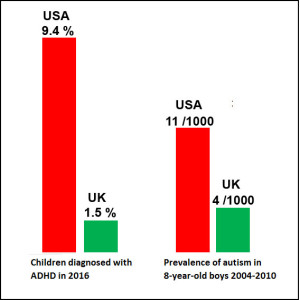 Integrative Food, Nutrition and Metabolism, 2018, 5(4): 1-2
Integrative Food, Nutrition and Metabolism, 2018, 5(4): 1-2
This editorial explores possible nutritional reasons for the huge difference between the United States and the United Kingdom in numbers of children diagnosed with ADHD or autism.
After two separate studies in the UK showed that food dyes with or without sodium benzoate led to hyperactivity symptoms in all children representing the general population, warnings were added to foods containing them. These same dyes also contain what the US considers allowable levels of lead, arsenic, mercury, and cadmium. The requirement for warning labels enabled British parents to make better choices – and also encouraged companies to replace these dyes with natural colors or even “real food” ingredients for those countries requiring labels.
A further issue is zinc. Zinc is required to transport heavy metals – such as lead, arsenic, mercury and cadmium – out of the body, but the child eating food dyes has been shown to lose zinc.
QUOTE: “A model has been published to show how lead and inorganic mercury exposures may contribute to the development of autism and ADHD via the metabolic loss of zinc.” (Dufaualt 2009, Dufault 2012)
Besides food dyes, high fructose corn syrup (HFCS) also lowers zinc levels. Because of trade barriers in the UK, however, the British aren’t eating much HFCS, while Americans consume up to 41.4 pounds per person (2016 information). A study of over 1000 mothers and children recently confirmed that high intake of HFCS during pregnancy is related to lower intelligence in the children some years later (Cohen et al, 2018).
NOTE: Cohen found diet sodas equally harmful, so if you are pregnant, don’t switch to diet soda. Have you tried drinking water? Carbonated water? How about carbonated water with some fruit juice?
Dufault also noted that in the US only women of lower income benefit from the nutritional foods and education provided by the WIC (Women Infants & Children) program. Since states with the highest WIC participation have the lowest autism rates, she suggests providing this program to all pregnant women regardless of income.
QUOTE: “Warning label requirements for foods with ingredients found to lower cognition or increase hyperactivity and inattention in children may serve to reduce autism and ADHD prevalence in the U.S. as parents will be able to make healthier food choices for their children.”
NOTE: While all seem to agree that in the UK, autism and ADHD are at a much lower level than in the US, some believe it has to do with the way they are diagnosed, or that in the USA we just notice it better (?), or some other factor – anything but the food, right?
Full Text
Related articles:
1. UK Autism Rates Plateau While US Rates Continue to Climb (Medscape 2013)
2. The Estimated Prevalence of Autism among Adults with Learning Disabilities in England (Emerson 2010)
3. Prevalence and Incidence Rates of Autism in the UK: Time Trend From 2004–2010 in Children Aged 8 Years (Taylor 2013)
4. Advice to Parents from the Food Standards Agency, UK




















